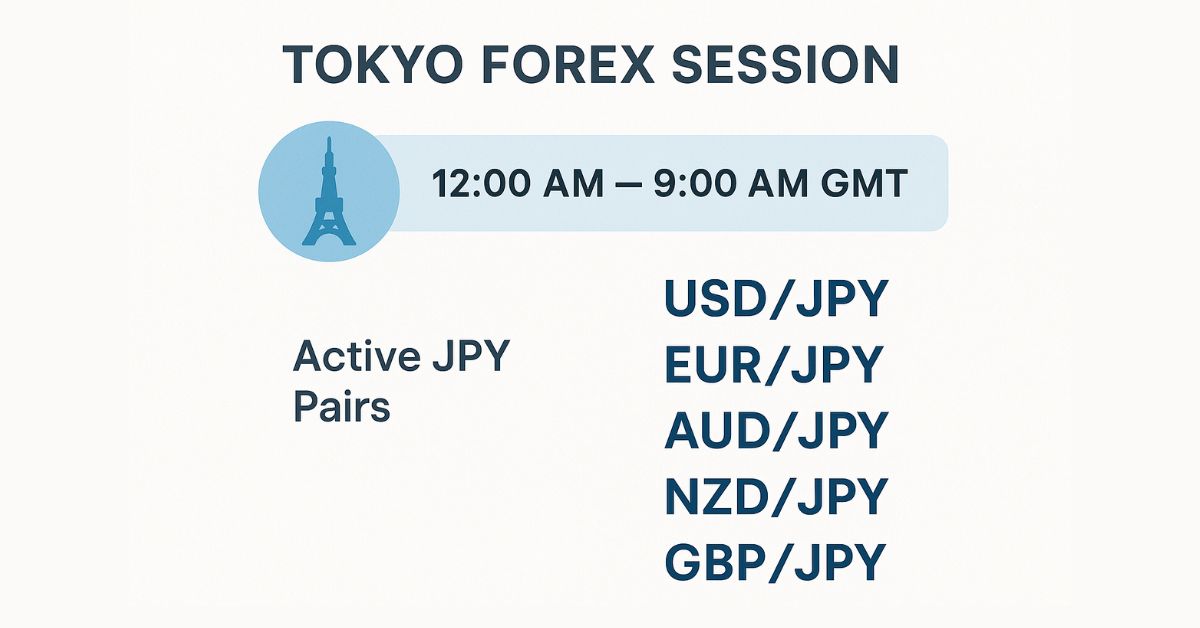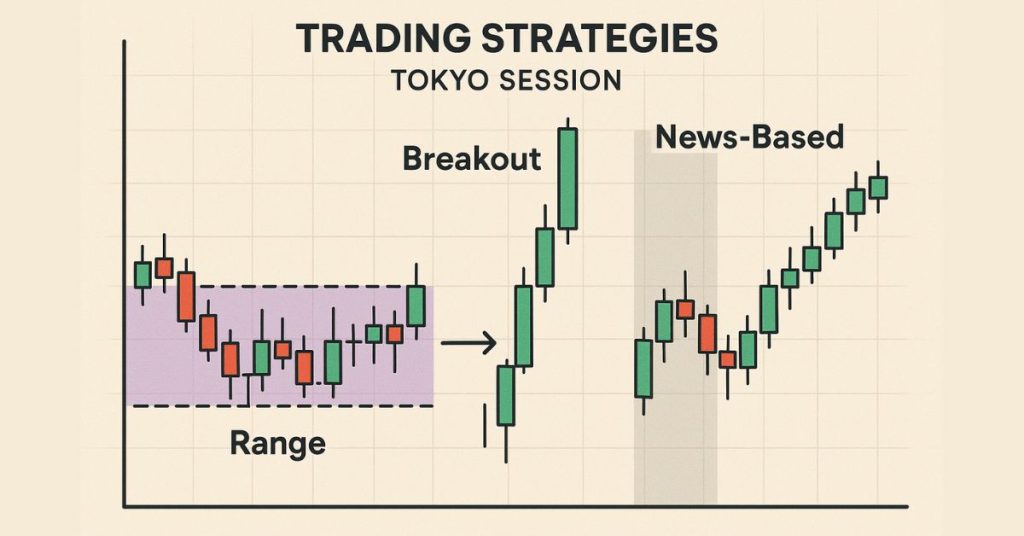
The Tokyo (Asian) forex session runs from 12:00 AM to 9:00 AM GMT. The most active and responsive currency pairs during this time frame are typically those based on the Japanese yen, such as USD/JPY, EUR/JPY, AUD/JPY, NZD/JPY, and GBP/JPY. Though liquidity is lower than in European or American hours, volatility often spikes around key Asian economic releases, making this session ideal for strategic day trading.
Open a Forex Trading Live AccountKey Takeaways
- The Tokyo (Asian) session operates from 12:00 AM to 9:00 AM GMT (7:00 AM to 4:00 PM Tokyo time).
- About 20% of global forex volume is traded during the Asian session.
- Japan’s forex market alone averaged USD 462.1 billion/day in April 2025, up 14.6% vs. October 2024.
- Within Japan, USD/JPY accounts for ~63.1% of spot turnover.
- Key pairs during Tokyo: USD/JPY, EUR/JPY, AUD/JPY, NZD/JPY, and GBP/JPY.
- Use breakout, range, and news-driven strategies tailored for Tokyo’s structure.
- Partnering with a broker like Defcofx (with high leverage, low spreads, and fast withdrawals) can enhance your execution edge.
Why the Tokyo Session Is Special
Market Share & Volume
The daily turnover of the global forex market is estimated to be USD 7.5 trillion (April 2022). Roughly 20% of that volume transacts during the Asian (Tokyo) window. Japan’s domestic FX activity is also formidable. In April 2025, its local market averaged USD 462.1 billion/day. In that same period, spot transactions in USD/JPY made up 63.11% of total spot turnover in Japan.
These numbers show that while global hotspots like London may dominate headlines, Tokyo is far from dormant, especially for yen currency pairs.
Price Behavior, Liquidity & Volatility
Compared to London and New York, Tokyo typically has lower liquidity and gentler volatility. That said, it’s not static.
- The first hour or two often sees breakout attempts as markets respond to overnight Asian data.
- The Tokyo–London overlap (last hour of Tokyo) can become a hotspot for volatility, especially for cross-JPY pairs.
- Smaller participants may see their orders move markets more in Tokyo due to lighter institutional flows.
Tokyo is essentially a more sedate, organized session with pockets of opportunity, if you know where to look.
5 Best Forex Pairs to Trade During Tokyo
Some pairs outperform others in the Asian session. Below is a refined overview:
| Currency Pair | Behavior During Tokyo | Drivers & Sensitivities | Ideal Strategy Use |
| USD/JPY | Highest liquidity among JPY pairs | BOJ decisions, Japanese macro data, risk sentiment, correlation to U.S. dollar | Breakouts, intraday momentum |
| EUR/JPY | Moderate activity, rises during overlap | European and Japanese news influence | Cross-section trades, overlap strategies |
| AUD/JPY | More volatile than many | Sensitive to Australian data, commodity prices, China demand | Trend following, breakout |
| NZD/JPY | Less volume but decent range | NZ economic releases, agricultural exports | Range or carry trades |
| GBP/JPY | Quieter early, spikes in overlap | UK rates, European flows, appetite shifts | Swing trades during overlap |
Why JPY Currency Pairs Dominate
Since Japan is a major financial center, its currency is deeply embedded in the regional FX ecosystem. Pairs with JPY are more responsive in Asia because traders around Japan, Australia, China, and Southeast Asia are active participants. The influence of Japanese monetary policy gives these pairs structural reactivity even during quieter hours.
5 Key Market Drivers & Catalysts
To trade Tokyo pairs effectively, understanding what can move them is essential. Some major drivers:
Japanese Macro & Policy
- BOJ interest rate changes, yield curve control, and bond purchases often shift JPY pairs sharply.
- Retail sales, the trade balance, inflation (CPI/PPI), and the Tankan survey are also very important.
Asia-Pacific Economy
Australia, New Zealand, and China releases (PMI, employment, and exports) can ripple across AUD/JPY and NZD/JPY.
Risk Sentiment & Safe-Haven Moves
During risk aversion or geopolitical shocks, money tends to flow into yen as a safe haven. For example, in March 2025, speculators placed record bets on JPY appreciation, driven by hawkish BOJ expectations and falling U.S. Treasury yields.
Carry Trade Reversals
The popular strategy of borrowing yen to finance higher-yielding assets can unwind rapidly, causing abrupt reversals.
Session Overlaps
- The Tokyo–Sydney overlap (12:00–2:00 AM GMT) tends to boost AUD/JPY and NZD/JPY activity.
- The Tokyo–London overlap (8:00–9:00 AM GMT) can inject fresh volatility into EUR/JPY and GBP/JPY.
Trading Strategies Customized to Tokyo

Because Tokyo has distinct traits, you’ll need adapted strategies. Here are a few expanded approaches:
Breakout / Momentum Plays
- In the early hours, identify the initial high/low as a range.
- Place pending orders (buy stop above high / sell stop below low) with confirmation (volume, momentum indicators).
- Use a modest stop inside the range and target 1.5× to 2× risk.
Breakouts near the Tokyo–London overlap often see stronger conviction due to refreshed flows.
Range / Mean Reversion
- In quieter mid-session periods, prices often drift between clear support and resistance zones.
- Use oscillators like RSI or stochastic to watch for overbought/oversold touches.
- Enter near extremes; exit toward the median or opposite side.
News-Based Trading
- Construct a trade plan ahead of major releases (e.g., Japan CPI, BOJ statements, and Australia jobs).
- Use pending orders to catch fast directional moves.
- Keep stops tight to limit whipsaw risk, as news can overshoot or reverse sharply.
Carry / Trend-Based Approach
- If yields favor AUD or NZD vs JPY, entering a trend position in those pairs can be profitable over hours.
- Trail stops carefully, and monitor sentiment for sudden reversals.
Overlap Exploitation
- Many traders wait to take action until overlap periods (Tokyo–London), when liquidity and momentum amplify.
- Build setups just before overlap and enter when volume confirms direction.
Tokyo Session Trade Setup: USD/JPY Case Study
To make things more practical, let’s walk through a real-world-style example of how a trade might unfold during the Tokyo session.
Scenario:
- Instrument: USD/JPY
- Event: Japanese inflation data comes out stronger than expected just before Tokyo markets open.
- Impact: A strong inflation reading usually supports the Japanese yen, leading to potential weakness in USD/JPY.
Step-by-Step Setup:
- Market Bias: Based on the news, the expectation is that the yen will strengthen, so the bias is towards selling USD/JPY.
- Preparation: Mark the prior day’s high and low, along with any major support or resistance zones that price has been respecting.
- Entry Point: If price breaks below the early Tokyo session support zone (with volume confirming momentum), a short entry is triggered.
- Risk Management: Place the stop-loss slightly above the breakout level to minimize risk if the market reverses.
- Profit Target: Aim for at least 1.5× the risk taken, or let profits run into the Tokyo–London overlap when liquidity and volatility are often at their peak.
Why This Works: Many trades during the Tokyo session gain momentum once European traders join in, making the Tokyo–London overlap a decisive period. A disciplined approach, combining news, technical levels, and proper risk management, helps traders capitalize on such opportunities.
Performance & Market Stats
Here are some compelling numbers to strengthen E-E-A-T credibility:
- Japan’s FX market grew by 14.6% in April 2025 vs. Oct 2024.
- Of that activity, 55.7% came from forex swaps and 28.9% from spot trades.
- In Japan, USD/JPY dominates spot trades (~63.11% of spot volume).
- Globally, major pairs (7 of them) account for ~67.4% of total forex volume.
These stats show how concentrated activity is around a few pairs and how central JPY crosses are in the Asia region.
How Defcofx Supports Tokyo Session Traders
Trading during the Tokyo session demands precision, cost-efficiency, and fast execution. Here’s how Defcofx supports these:
- High Leverage Options: Trade with leverage up to 1:2000, maximizing potential in smaller intraday moves.
- 40% Welcome Bonus: For first-time deposits (minimum $1,000), Defcofx offers a 40% bonus, boosting your effective margin.
- No Commissions or Swap Fees: Spreads from 0.3 pips, with zero hidden costs, make short-term trading more economical.
- Global Reach & Multilingual Support: Available worldwide, with multiple languages, helping traders in Asia, Europe, Africa, and beyond.
- Fast Support & Withdrawals: Withdrawal requests are processed within 4 business hours, including weekends, which is very rare in forex.
Because Tokyo session ranges are tighter than later sessions, every pip counts. Lower costs and fast execution from Defcofx give you an edge.
Risks, Best Practices & Trade Management
No strategy is foolproof. Here are key cautions and best practices:
- Whipsaws & False Breakouts: Tokyo’s environment can generate fake-outs; always use stop-losses.
- Thin Liquidity Periods: Avoid trading during extremely quiet hours (e.g., early hours before overlap) unless a strong signal emerges.
- Overleverage Dangers: 1:2000 is powerful. Only risk a small percentage (1–2%) of capital per trade.
- Sudden News Impact: Unexpected BOJ interventions or geopolitical events may cause slippage.
- Broker Reliability: Always choose regulated brokers, monitor execution latency, and test strategies in demo before going live.
Final Thoughts on Tokyo Session Forex Pairs
The Tokyo session forex pairs, especially JPY crosses like USD/JPY, EUR/JPY, AUD/JPY, NZD/JPY, and GBP/JPY, are at the heart of early-day Asian trading. While volatility is often lower than in London or New York, Tokyo offers structured ranges, predictable behavior, and bursts of momentum around macro releases.
To trade effectively, you need strategies tailored to this session; breakouts, ranges, news plays, and overlap timing are all valuable tools. But strategy alone isn’t enough: you also need a broker designed for precision, low cost, and fast execution. That’s where Defcofx shines, offering 1:2000 leverage, spreads from 0.3 pips, no commissions/swaps, a 40% welcome bonus, and 4-hour withdrawals.
Open a Trading Live AccountFrequently Asked Questions (FAQs)
The Tokyo session runs from 12:00 AM to 9:00 AM GMT (7:00 AM–4:00 PM Tokyo local time). It overlaps with Sydney early on and London in the last hour, creating added trading opportunities.
The most active pairs are JPY crosses: USD/JPY, EUR/JPY, AUD/JPY, NZD/JPY, and GBP/JPY. These pairs show higher liquidity and responsiveness to Asian economic events compared to others during Tokyo hours.
Yes, it can be. Tokyo is calmer than London or New York, offering structured moves and fewer whipsaws. Beginners should still use small lot sizes, strict risk management, and a reliable broker to avoid losses.
USD/JPY dominates because the yen is central to Asia, and Japan is the world’s third-largest economy. The pair responds quickly to Japanese data releases, Bank of Japan policy, and overall global risk sentiment.
Japan’s forex market averaged USD 462.1 billion per day in April 2025, a 14.6% increase from October 2024. Spot USD/JPY trades alone accounted for about 63% of Japan’s spot market turnover.
Popular strategies include breakouts during the first hours, range trading in mid-session, and news-based trades around economic releases. Overlap periods with London are excellent for momentum and volatility-driven plays.
Tokyo tends to be less volatile than London, offering smaller intraday ranges (30–60 pips typical for majors). However, volatility spikes around Japanese or Australian economic data and during the Tokyo–London overlap.
Yes. Scalp trading works well if you focus on liquid currency pairs like USD/JPY or AUD/JPY. With tight spreads (0.3 pips at Defcofx) and fast execution, scalpers can capture small but consistent profits.
Key drivers include Bank of Japan policy updates, Japanese CPI, trade balance, the Tankan survey, Australian employment, and Chinese PMI. Traders often set alerts and plan trades around these announcements for maximum efficiency.
Defcofx offers 1:2000 leverage, spreads from 0.3 pips, no swaps or commissions, a 40% welcome bonus, and 4-hour withdrawals, including weekends. These features give traders an edge in Tokyo’s lower-range environment.
Defcofx Forex Articles You Shouldn’t Miss
Discover powerful forex strategies in these top reads from Defcofx.


